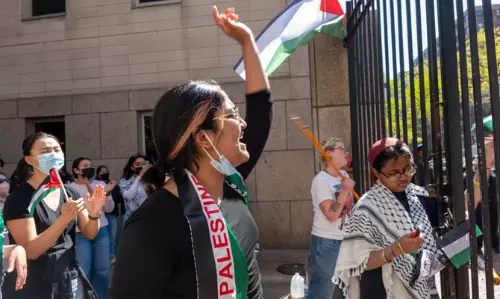
Supreme Court verdict and balanced rights
text_fieldsThe Supreme Court has through a landmark verdict on Wednesday, decreed that protests occupying public ways and public space for an indefinite period cannot be accepted, and that though democratic rights and protests should go hand in hand, protests should be held only in designated places. The judgement by the bench pf Justices SK Kaul, Aniruddha Bose and Krishna Murari was delivered on a petition filed by senior lawyer Amit Sahni and former BJP MLA Nanda Kishore Garg. The petitioners had made a case against the non-violent protest sit-in in by women at Shaheen Bagh, Delhi which lasted from 14 December last year to 24 March this year against the Citizenship Amendment Act (CAA) passed by the parliament. The apex court pointed out that the sit-in, which started as a lawful protest in line with constitutional rights, later turned out to be an occupation of Shaheen Bagh and blocked the entire road causing inconvenience to commuters. The bench also made an accusative observation about the administration that the latter need not have waited until the court's intervention to remove the road block by itself. The judges also reminded that occupying this space, or for that matter any other public space, for protest cannot be accepted and that action should have been taken against occupying a whole area which thus caused hurdle for public traffic.
In February last, when the petition came up for consideration, the Supreme Court had accepted it for hearing, and at that time itself made its preliminary observation on the need for making public spaces protest-free, and wondered what would happen if people started holding protests all over. And it also appointed senior lawyers Sanjay Hegde and Sadhana Ramachandran to talk to the protesters. Although following the talks, one side of the road was opened for traffic, the women there were not prepared to call off the strike entirely. The mediators after arduous attempt to reach an amicable solution, submitted their report in a sealed envelope to the court on 24 February. In the meantime, the Covid pandemic aggravated in Delhi and on 24 March, police demolished the protest tent, and out of fear of virus spread the protest was suspended. However, since the petitioners persisted with the plea for restricting the protest, the court proceeded with the case. When the final hearing started on 21 September, the court had opined that each protest is different from the other, therefore a global policy about protests cannot be formulated, and when there is a conflict between two constitutionally guaranteed rights - here the right to protest and the right to free movement - there should be a balanced course between them. And while underling these earlier observations, the highest court has now given a judgement in unequivocal terms that protests that create traffic blocks cannot be allowed.
Protests in line with law is a distinct and essential feature of democracy. And whether the protesters are a majority or a minority and whether their demands are right or wrong, is beside the point here. Article 19 of the Constitution guarantees to the victims affected in any issue the right to express their grievance or outrage. Hence the judiciary, at all levels from lower courts to the Supreme Court, have always upheld this noble principle of democracy through their verdicts. In the Himmat Lal K Shah vs Police Commissioner Ahmedabad case of 15 Sep 1972, the 5 June 2011 case of Anna Hazare's Ramlila Maidan Incident and in the Mazdoor Kisan Shakti Sanghatan's Delhi Jantar Mantar agitation case of 23 July 201, the Supreme Court had allowed the anti-government strikes in a manner honouring the sanctity of the Constitution that grants the democratic right to freedom of expression. Through such judgements, the Supreme Court had endorsed the right to freedom of expression, to organise sit-in and peaceful strikes as a fundamental feature of democracy. In a country like ours, the people have a right to raise their voice against government decisions and actions. And the government is bound to heed them and encourage such rights. Freedom of expression should be viewed in its totality and promoted. The government should not, by using its executive authority and in the name of reasonable controls, strangle such civil rights. The Supreme Court had made these observations in the Ram Lila case.
On Wednesday, when interpreting the constitutionally guaranteed right to protest and to assemble in the Shaheen Bagh case, the Supreme Court does reiterate that protection of the rights should be balanced. However, the key question is whether this court verdict in final effect reflects that balance or a weightage in favour of those who perceive even a peaceful clamour for protection of victims' rights as a nuisance.
























